Maternal and Child Undernutrition: Causes, Effects, and Solutions
VerifiedAdded on 2023/01/16
|17
|4412
|45
Essay
AI Summary
This essay provides a detailed analysis of maternal and child undernutrition, a significant public health challenge, particularly in Australia. It highlights the detrimental effects of undernutrition, including protein-energy and micronutrient deficiencies, on both mothers and children. The essay explores the factors contributing to undernutrition, such as inadequate food consumption, infectious diseases, and poverty, and their impact on fetal development, infant health, and long-term cognitive and physical outcomes. Furthermore, the essay examines the health risks associated with micronutrient deficiencies like iron and vitamin A deficiencies. It also emphasizes the importance of interventions, including balanced diets, breastfeeding promotion, and micronutrient supplementation, to address and mitigate the consequences of undernutrition. The essay concludes by outlining nutrition-specific and nutrition-sensitive interventions to combat undernutrition and improve health outcomes for mothers and children, particularly in low and middle-income areas. The essay also discusses the interventions required to address general nutrient consumption in mothers and children.
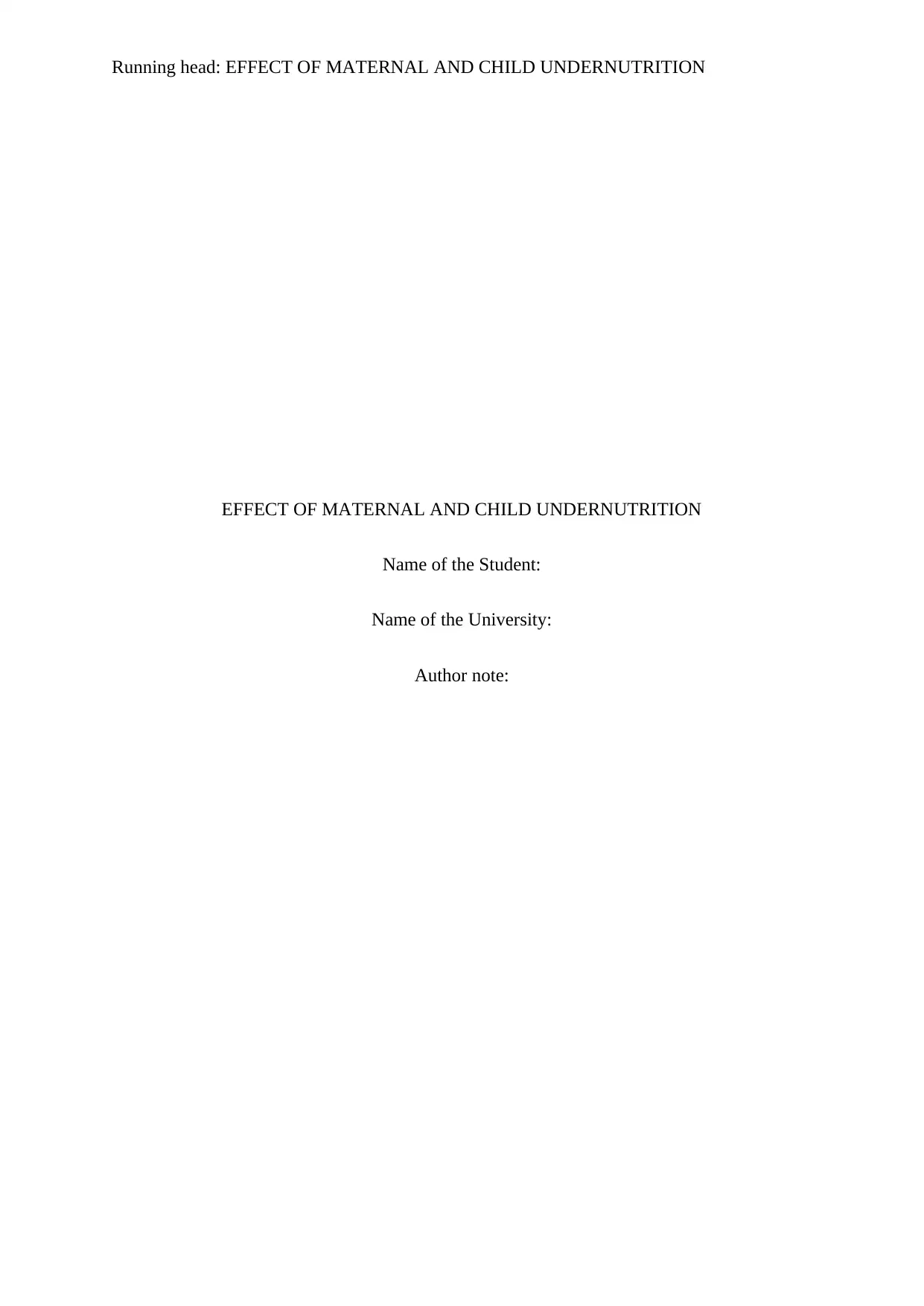
Running head: EFFECT OF MATERNAL AND CHILD UNDERNUTRITION
EFFECT OF MATERNAL AND CHILD UNDERNUTRITION
Name of the Student:
Name of the University:
Author note:
EFFECT OF MATERNAL AND CHILD UNDERNUTRITION
Name of the Student:
Name of the University:
Author note:
Paraphrase This Document
Need a fresh take? Get an instant paraphrase of this document with our AI Paraphraser
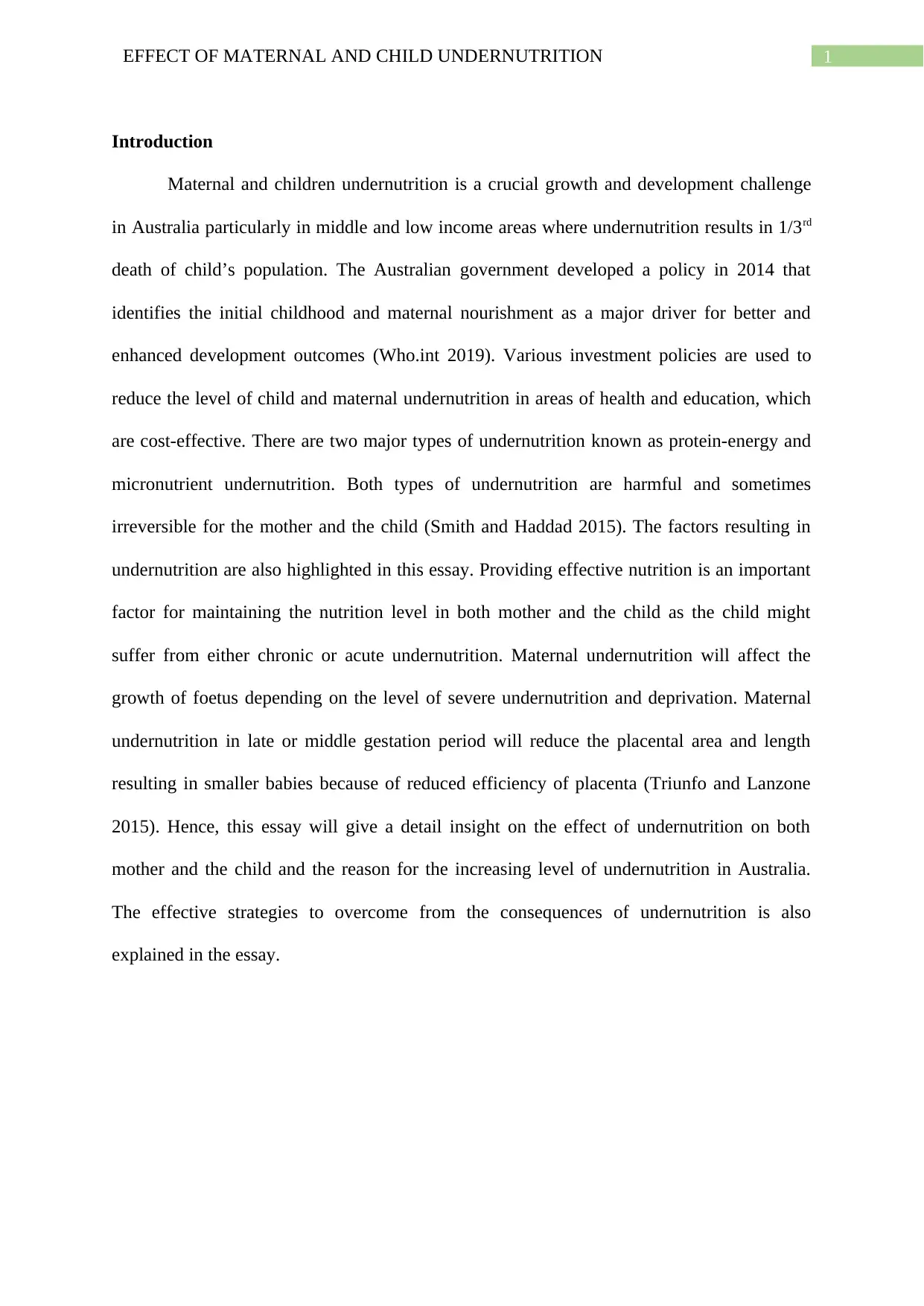
1EFFECT OF MATERNAL AND CHILD UNDERNUTRITION
Introduction
Maternal and children undernutrition is a crucial growth and development challenge
in Australia particularly in middle and low income areas where undernutrition results in 1/3rd
death of child’s population. The Australian government developed a policy in 2014 that
identifies the initial childhood and maternal nourishment as a major driver for better and
enhanced development outcomes (Who.int 2019). Various investment policies are used to
reduce the level of child and maternal undernutrition in areas of health and education, which
are cost-effective. There are two major types of undernutrition known as protein-energy and
micronutrient undernutrition. Both types of undernutrition are harmful and sometimes
irreversible for the mother and the child (Smith and Haddad 2015). The factors resulting in
undernutrition are also highlighted in this essay. Providing effective nutrition is an important
factor for maintaining the nutrition level in both mother and the child as the child might
suffer from either chronic or acute undernutrition. Maternal undernutrition will affect the
growth of foetus depending on the level of severe undernutrition and deprivation. Maternal
undernutrition in late or middle gestation period will reduce the placental area and length
resulting in smaller babies because of reduced efficiency of placenta (Triunfo and Lanzone
2015). Hence, this essay will give a detail insight on the effect of undernutrition on both
mother and the child and the reason for the increasing level of undernutrition in Australia.
The effective strategies to overcome from the consequences of undernutrition is also
explained in the essay.
Introduction
Maternal and children undernutrition is a crucial growth and development challenge
in Australia particularly in middle and low income areas where undernutrition results in 1/3rd
death of child’s population. The Australian government developed a policy in 2014 that
identifies the initial childhood and maternal nourishment as a major driver for better and
enhanced development outcomes (Who.int 2019). Various investment policies are used to
reduce the level of child and maternal undernutrition in areas of health and education, which
are cost-effective. There are two major types of undernutrition known as protein-energy and
micronutrient undernutrition. Both types of undernutrition are harmful and sometimes
irreversible for the mother and the child (Smith and Haddad 2015). The factors resulting in
undernutrition are also highlighted in this essay. Providing effective nutrition is an important
factor for maintaining the nutrition level in both mother and the child as the child might
suffer from either chronic or acute undernutrition. Maternal undernutrition will affect the
growth of foetus depending on the level of severe undernutrition and deprivation. Maternal
undernutrition in late or middle gestation period will reduce the placental area and length
resulting in smaller babies because of reduced efficiency of placenta (Triunfo and Lanzone
2015). Hence, this essay will give a detail insight on the effect of undernutrition on both
mother and the child and the reason for the increasing level of undernutrition in Australia.
The effective strategies to overcome from the consequences of undernutrition is also
explained in the essay.
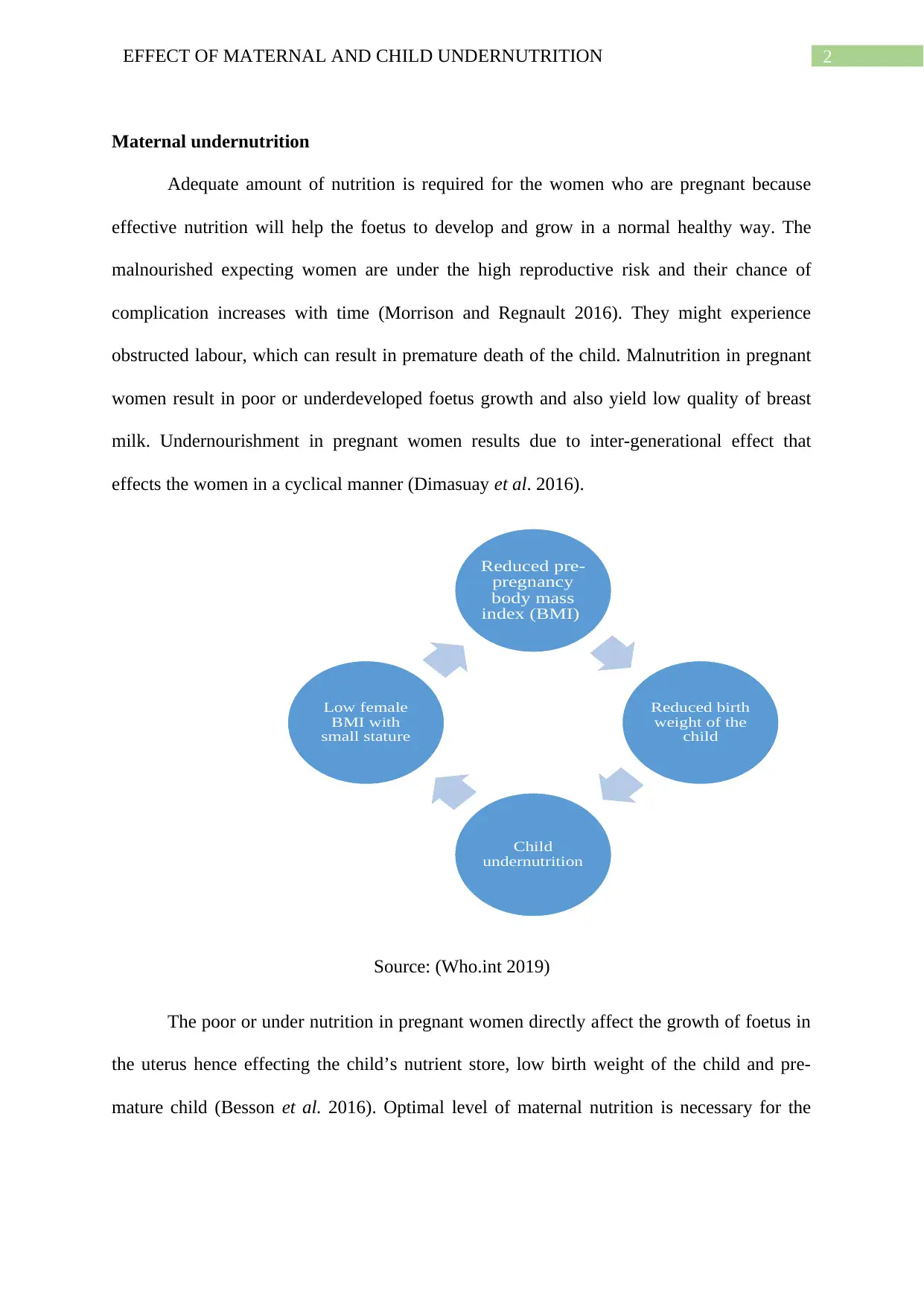
2EFFECT OF MATERNAL AND CHILD UNDERNUTRITION
Maternal undernutrition
Adequate amount of nutrition is required for the women who are pregnant because
effective nutrition will help the foetus to develop and grow in a normal healthy way. The
malnourished expecting women are under the high reproductive risk and their chance of
complication increases with time (Morrison and Regnault 2016). They might experience
obstructed labour, which can result in premature death of the child. Malnutrition in pregnant
women result in poor or underdeveloped foetus growth and also yield low quality of breast
milk. Undernourishment in pregnant women results due to inter-generational effect that
effects the women in a cyclical manner (Dimasuay et al. 2016).
Source: (Who.int 2019)
The poor or under nutrition in pregnant women directly affect the growth of foetus in
the uterus hence effecting the child’s nutrient store, low birth weight of the child and pre-
mature child (Besson et al. 2016). Optimal level of maternal nutrition is necessary for the
Reduced pre-
pregnancy
body mass
index (BMI)
Reduced birth
weight of the
child
Child
undernutrition
Low female
BMI with
small stature
Maternal undernutrition
Adequate amount of nutrition is required for the women who are pregnant because
effective nutrition will help the foetus to develop and grow in a normal healthy way. The
malnourished expecting women are under the high reproductive risk and their chance of
complication increases with time (Morrison and Regnault 2016). They might experience
obstructed labour, which can result in premature death of the child. Malnutrition in pregnant
women result in poor or underdeveloped foetus growth and also yield low quality of breast
milk. Undernourishment in pregnant women results due to inter-generational effect that
effects the women in a cyclical manner (Dimasuay et al. 2016).
Source: (Who.int 2019)
The poor or under nutrition in pregnant women directly affect the growth of foetus in
the uterus hence effecting the child’s nutrient store, low birth weight of the child and pre-
mature child (Besson et al. 2016). Optimal level of maternal nutrition is necessary for the
Reduced pre-
pregnancy
body mass
index (BMI)
Reduced birth
weight of the
child
Child
undernutrition
Low female
BMI with
small stature
⊘ This is a preview!⊘
Do you want full access?
Subscribe today to unlock all pages.

Trusted by 1+ million students worldwide
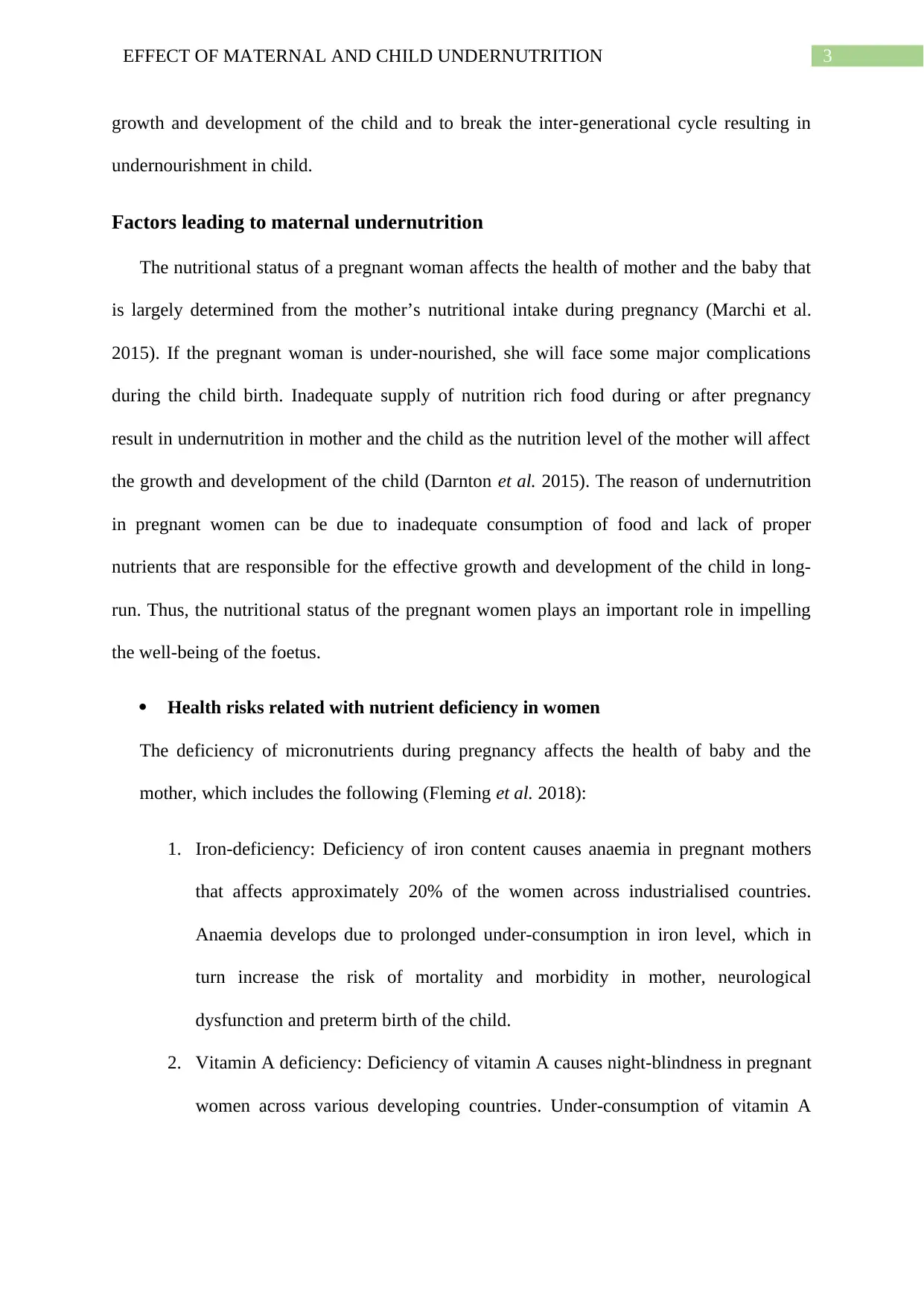
3EFFECT OF MATERNAL AND CHILD UNDERNUTRITION
growth and development of the child and to break the inter-generational cycle resulting in
undernourishment in child.
Factors leading to maternal undernutrition
The nutritional status of a pregnant woman affects the health of mother and the baby that
is largely determined from the mother’s nutritional intake during pregnancy (Marchi et al.
2015). If the pregnant woman is under-nourished, she will face some major complications
during the child birth. Inadequate supply of nutrition rich food during or after pregnancy
result in undernutrition in mother and the child as the nutrition level of the mother will affect
the growth and development of the child (Darnton et al. 2015). The reason of undernutrition
in pregnant women can be due to inadequate consumption of food and lack of proper
nutrients that are responsible for the effective growth and development of the child in long-
run. Thus, the nutritional status of the pregnant women plays an important role in impelling
the well-being of the foetus.
Health risks related with nutrient deficiency in women
The deficiency of micronutrients during pregnancy affects the health of baby and the
mother, which includes the following (Fleming et al. 2018):
1. Iron-deficiency: Deficiency of iron content causes anaemia in pregnant mothers
that affects approximately 20% of the women across industrialised countries.
Anaemia develops due to prolonged under-consumption in iron level, which in
turn increase the risk of mortality and morbidity in mother, neurological
dysfunction and preterm birth of the child.
2. Vitamin A deficiency: Deficiency of vitamin A causes night-blindness in pregnant
women across various developing countries. Under-consumption of vitamin A
growth and development of the child and to break the inter-generational cycle resulting in
undernourishment in child.
Factors leading to maternal undernutrition
The nutritional status of a pregnant woman affects the health of mother and the baby that
is largely determined from the mother’s nutritional intake during pregnancy (Marchi et al.
2015). If the pregnant woman is under-nourished, she will face some major complications
during the child birth. Inadequate supply of nutrition rich food during or after pregnancy
result in undernutrition in mother and the child as the nutrition level of the mother will affect
the growth and development of the child (Darnton et al. 2015). The reason of undernutrition
in pregnant women can be due to inadequate consumption of food and lack of proper
nutrients that are responsible for the effective growth and development of the child in long-
run. Thus, the nutritional status of the pregnant women plays an important role in impelling
the well-being of the foetus.
Health risks related with nutrient deficiency in women
The deficiency of micronutrients during pregnancy affects the health of baby and the
mother, which includes the following (Fleming et al. 2018):
1. Iron-deficiency: Deficiency of iron content causes anaemia in pregnant mothers
that affects approximately 20% of the women across industrialised countries.
Anaemia develops due to prolonged under-consumption in iron level, which in
turn increase the risk of mortality and morbidity in mother, neurological
dysfunction and preterm birth of the child.
2. Vitamin A deficiency: Deficiency of vitamin A causes night-blindness in pregnant
women across various developing countries. Under-consumption of vitamin A
Paraphrase This Document
Need a fresh take? Get an instant paraphrase of this document with our AI Paraphraser
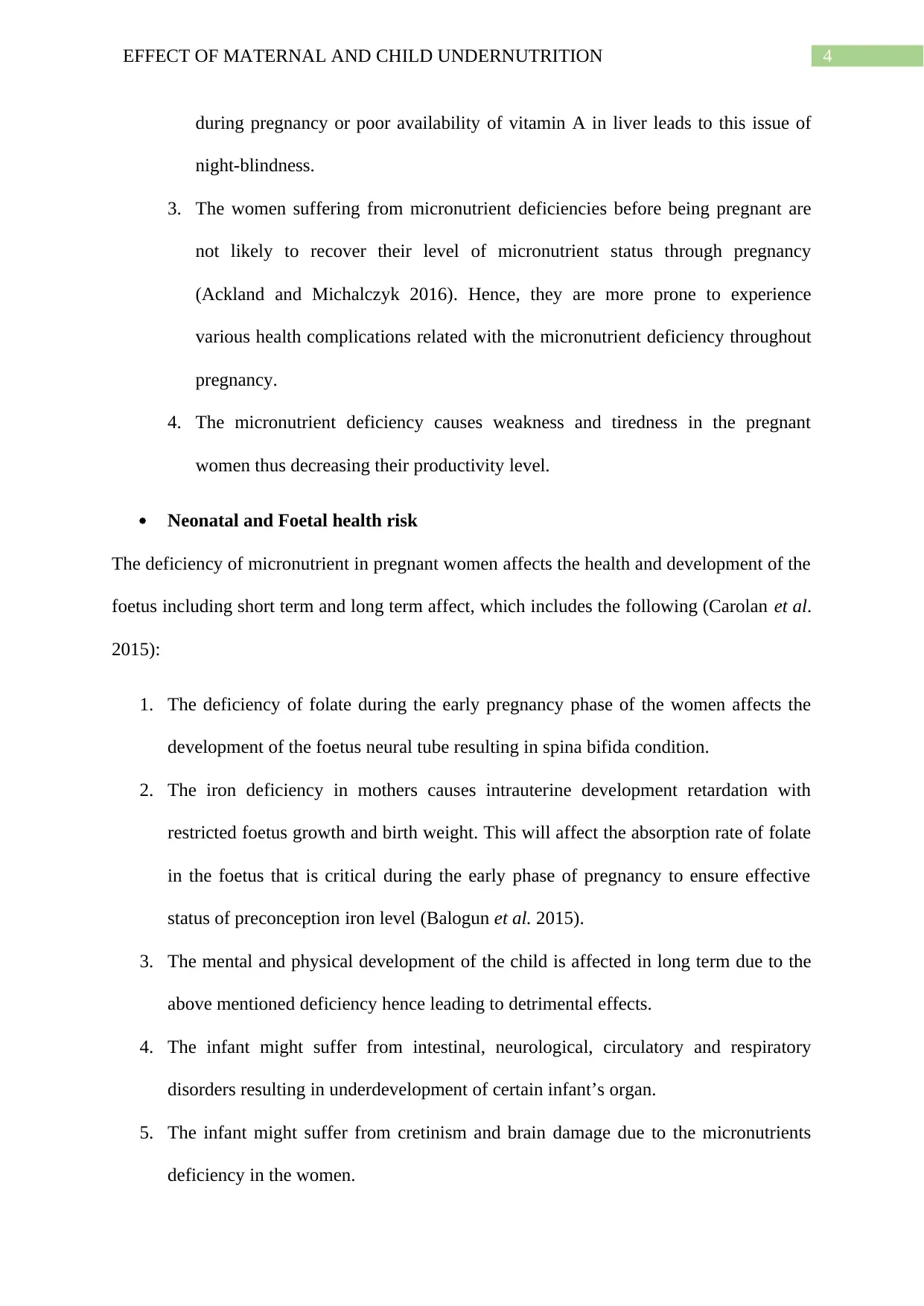
4EFFECT OF MATERNAL AND CHILD UNDERNUTRITION
during pregnancy or poor availability of vitamin A in liver leads to this issue of
night-blindness.
3. The women suffering from micronutrient deficiencies before being pregnant are
not likely to recover their level of micronutrient status through pregnancy
(Ackland and Michalczyk 2016). Hence, they are more prone to experience
various health complications related with the micronutrient deficiency throughout
pregnancy.
4. The micronutrient deficiency causes weakness and tiredness in the pregnant
women thus decreasing their productivity level.
Neonatal and Foetal health risk
The deficiency of micronutrient in pregnant women affects the health and development of the
foetus including short term and long term affect, which includes the following (Carolan et al.
2015):
1. The deficiency of folate during the early pregnancy phase of the women affects the
development of the foetus neural tube resulting in spina bifida condition.
2. The iron deficiency in mothers causes intrauterine development retardation with
restricted foetus growth and birth weight. This will affect the absorption rate of folate
in the foetus that is critical during the early phase of pregnancy to ensure effective
status of preconception iron level (Balogun et al. 2015).
3. The mental and physical development of the child is affected in long term due to the
above mentioned deficiency hence leading to detrimental effects.
4. The infant might suffer from intestinal, neurological, circulatory and respiratory
disorders resulting in underdevelopment of certain infant’s organ.
5. The infant might suffer from cretinism and brain damage due to the micronutrients
deficiency in the women.
during pregnancy or poor availability of vitamin A in liver leads to this issue of
night-blindness.
3. The women suffering from micronutrient deficiencies before being pregnant are
not likely to recover their level of micronutrient status through pregnancy
(Ackland and Michalczyk 2016). Hence, they are more prone to experience
various health complications related with the micronutrient deficiency throughout
pregnancy.
4. The micronutrient deficiency causes weakness and tiredness in the pregnant
women thus decreasing their productivity level.
Neonatal and Foetal health risk
The deficiency of micronutrient in pregnant women affects the health and development of the
foetus including short term and long term affect, which includes the following (Carolan et al.
2015):
1. The deficiency of folate during the early pregnancy phase of the women affects the
development of the foetus neural tube resulting in spina bifida condition.
2. The iron deficiency in mothers causes intrauterine development retardation with
restricted foetus growth and birth weight. This will affect the absorption rate of folate
in the foetus that is critical during the early phase of pregnancy to ensure effective
status of preconception iron level (Balogun et al. 2015).
3. The mental and physical development of the child is affected in long term due to the
above mentioned deficiency hence leading to detrimental effects.
4. The infant might suffer from intestinal, neurological, circulatory and respiratory
disorders resulting in underdevelopment of certain infant’s organ.
5. The infant might suffer from cretinism and brain damage due to the micronutrients
deficiency in the women.
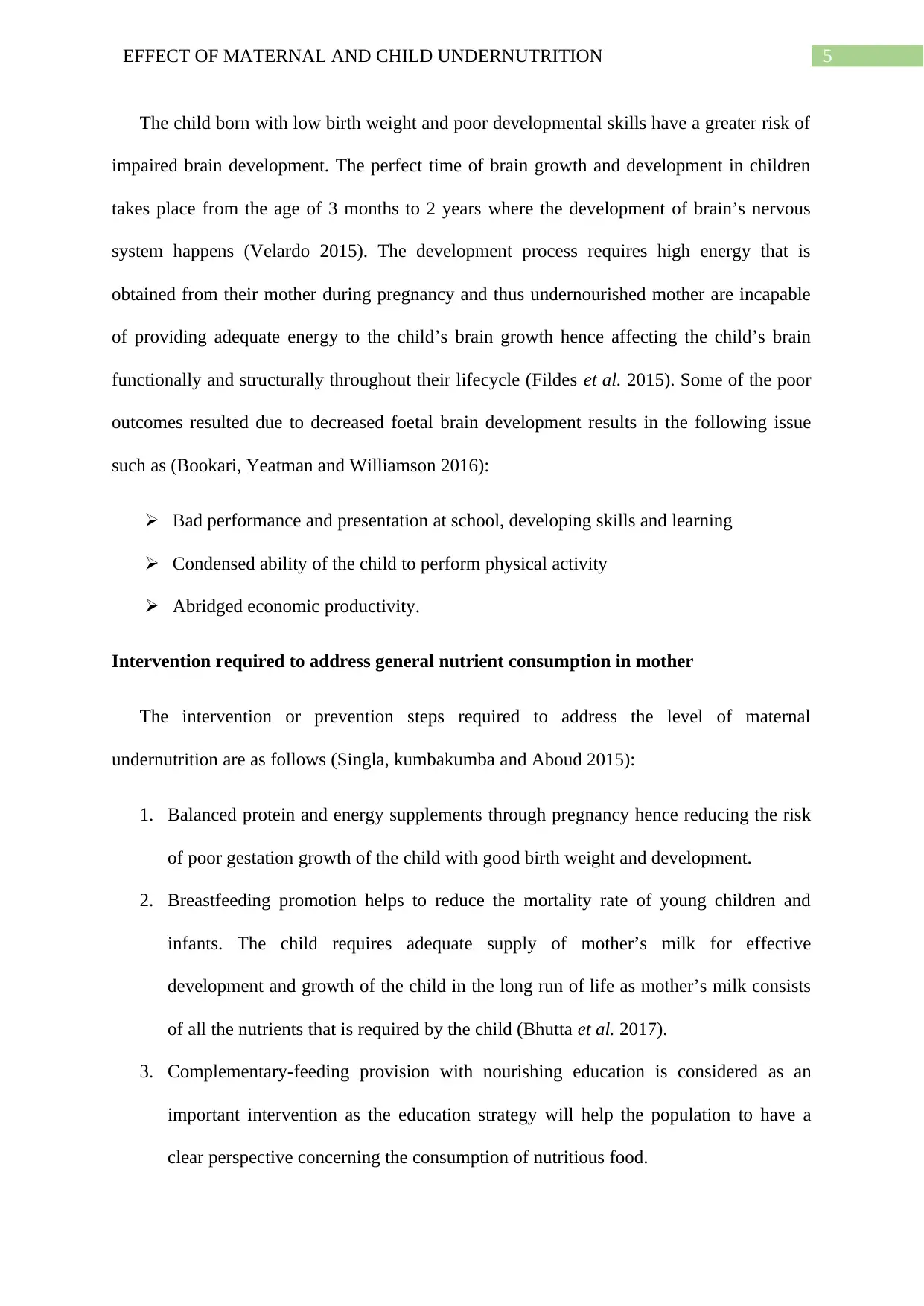
5EFFECT OF MATERNAL AND CHILD UNDERNUTRITION
The child born with low birth weight and poor developmental skills have a greater risk of
impaired brain development. The perfect time of brain growth and development in children
takes place from the age of 3 months to 2 years where the development of brain’s nervous
system happens (Velardo 2015). The development process requires high energy that is
obtained from their mother during pregnancy and thus undernourished mother are incapable
of providing adequate energy to the child’s brain growth hence affecting the child’s brain
functionally and structurally throughout their lifecycle (Fildes et al. 2015). Some of the poor
outcomes resulted due to decreased foetal brain development results in the following issue
such as (Bookari, Yeatman and Williamson 2016):
Bad performance and presentation at school, developing skills and learning
Condensed ability of the child to perform physical activity
Abridged economic productivity.
Intervention required to address general nutrient consumption in mother
The intervention or prevention steps required to address the level of maternal
undernutrition are as follows (Singla, kumbakumba and Aboud 2015):
1. Balanced protein and energy supplements through pregnancy hence reducing the risk
of poor gestation growth of the child with good birth weight and development.
2. Breastfeeding promotion helps to reduce the mortality rate of young children and
infants. The child requires adequate supply of mother’s milk for effective
development and growth of the child in the long run of life as mother’s milk consists
of all the nutrients that is required by the child (Bhutta et al. 2017).
3. Complementary-feeding provision with nourishing education is considered as an
important intervention as the education strategy will help the population to have a
clear perspective concerning the consumption of nutritious food.
The child born with low birth weight and poor developmental skills have a greater risk of
impaired brain development. The perfect time of brain growth and development in children
takes place from the age of 3 months to 2 years where the development of brain’s nervous
system happens (Velardo 2015). The development process requires high energy that is
obtained from their mother during pregnancy and thus undernourished mother are incapable
of providing adequate energy to the child’s brain growth hence affecting the child’s brain
functionally and structurally throughout their lifecycle (Fildes et al. 2015). Some of the poor
outcomes resulted due to decreased foetal brain development results in the following issue
such as (Bookari, Yeatman and Williamson 2016):
Bad performance and presentation at school, developing skills and learning
Condensed ability of the child to perform physical activity
Abridged economic productivity.
Intervention required to address general nutrient consumption in mother
The intervention or prevention steps required to address the level of maternal
undernutrition are as follows (Singla, kumbakumba and Aboud 2015):
1. Balanced protein and energy supplements through pregnancy hence reducing the risk
of poor gestation growth of the child with good birth weight and development.
2. Breastfeeding promotion helps to reduce the mortality rate of young children and
infants. The child requires adequate supply of mother’s milk for effective
development and growth of the child in the long run of life as mother’s milk consists
of all the nutrients that is required by the child (Bhutta et al. 2017).
3. Complementary-feeding provision with nourishing education is considered as an
important intervention as the education strategy will help the population to have a
clear perspective concerning the consumption of nutritious food.
⊘ This is a preview!⊘
Do you want full access?
Subscribe today to unlock all pages.

Trusted by 1+ million students worldwide
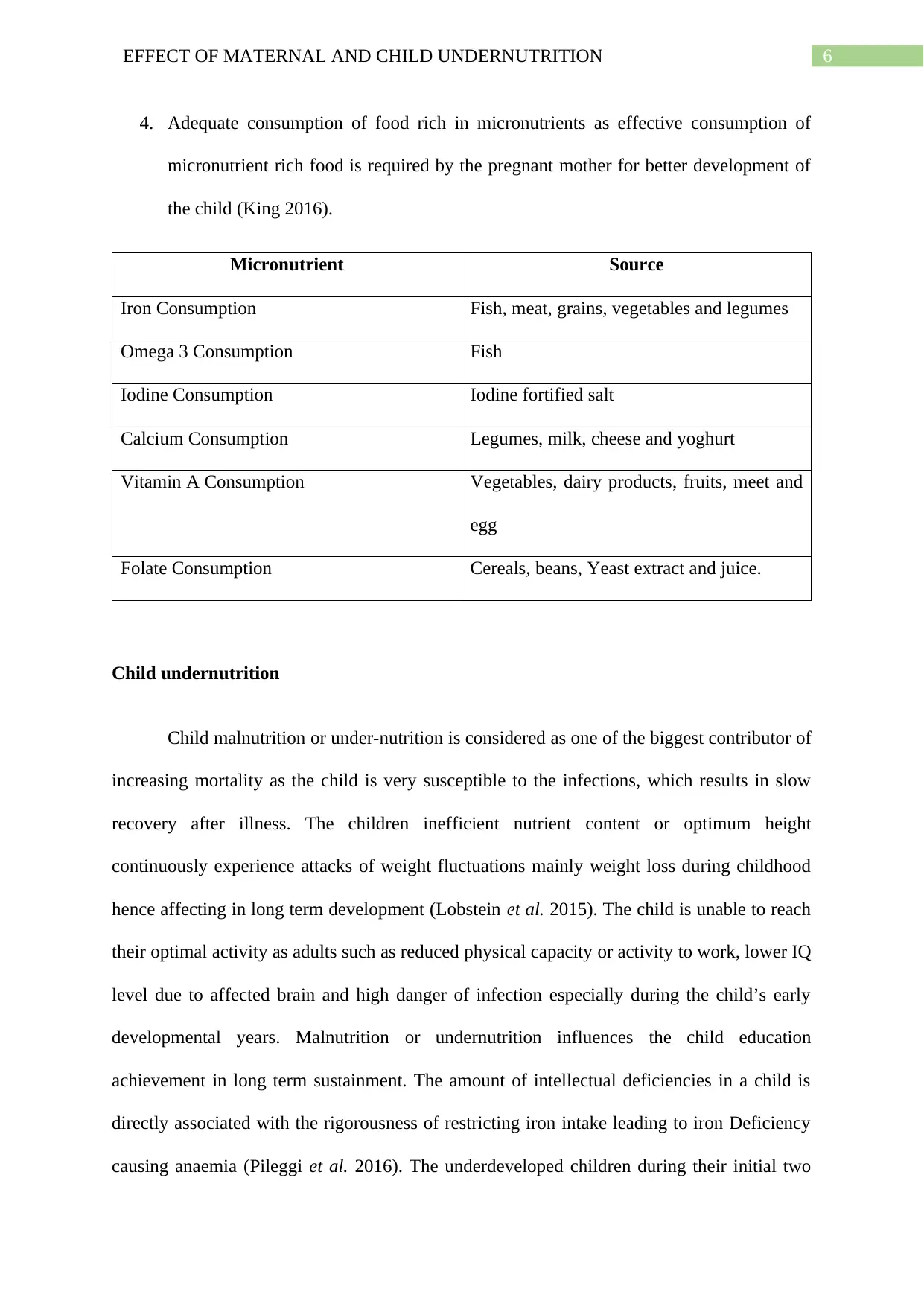
6EFFECT OF MATERNAL AND CHILD UNDERNUTRITION
4. Adequate consumption of food rich in micronutrients as effective consumption of
micronutrient rich food is required by the pregnant mother for better development of
the child (King 2016).
Micronutrient Source
Iron Consumption Fish, meat, grains, vegetables and legumes
Omega 3 Consumption Fish
Iodine Consumption Iodine fortified salt
Calcium Consumption Legumes, milk, cheese and yoghurt
Vitamin A Consumption Vegetables, dairy products, fruits, meet and
egg
Folate Consumption Cereals, beans, Yeast extract and juice.
Child undernutrition
Child malnutrition or under-nutrition is considered as one of the biggest contributor of
increasing mortality as the child is very susceptible to the infections, which results in slow
recovery after illness. The children inefficient nutrient content or optimum height
continuously experience attacks of weight fluctuations mainly weight loss during childhood
hence affecting in long term development (Lobstein et al. 2015). The child is unable to reach
their optimal activity as adults such as reduced physical capacity or activity to work, lower IQ
level due to affected brain and high danger of infection especially during the child’s early
developmental years. Malnutrition or undernutrition influences the child education
achievement in long term sustainment. The amount of intellectual deficiencies in a child is
directly associated with the rigorousness of restricting iron intake leading to iron Deficiency
causing anaemia (Pileggi et al. 2016). The underdeveloped children during their initial two
4. Adequate consumption of food rich in micronutrients as effective consumption of
micronutrient rich food is required by the pregnant mother for better development of
the child (King 2016).
Micronutrient Source
Iron Consumption Fish, meat, grains, vegetables and legumes
Omega 3 Consumption Fish
Iodine Consumption Iodine fortified salt
Calcium Consumption Legumes, milk, cheese and yoghurt
Vitamin A Consumption Vegetables, dairy products, fruits, meet and
egg
Folate Consumption Cereals, beans, Yeast extract and juice.
Child undernutrition
Child malnutrition or under-nutrition is considered as one of the biggest contributor of
increasing mortality as the child is very susceptible to the infections, which results in slow
recovery after illness. The children inefficient nutrient content or optimum height
continuously experience attacks of weight fluctuations mainly weight loss during childhood
hence affecting in long term development (Lobstein et al. 2015). The child is unable to reach
their optimal activity as adults such as reduced physical capacity or activity to work, lower IQ
level due to affected brain and high danger of infection especially during the child’s early
developmental years. Malnutrition or undernutrition influences the child education
achievement in long term sustainment. The amount of intellectual deficiencies in a child is
directly associated with the rigorousness of restricting iron intake leading to iron Deficiency
causing anaemia (Pileggi et al. 2016). The underdeveloped children during their initial two
Paraphrase This Document
Need a fresh take? Get an instant paraphrase of this document with our AI Paraphraser
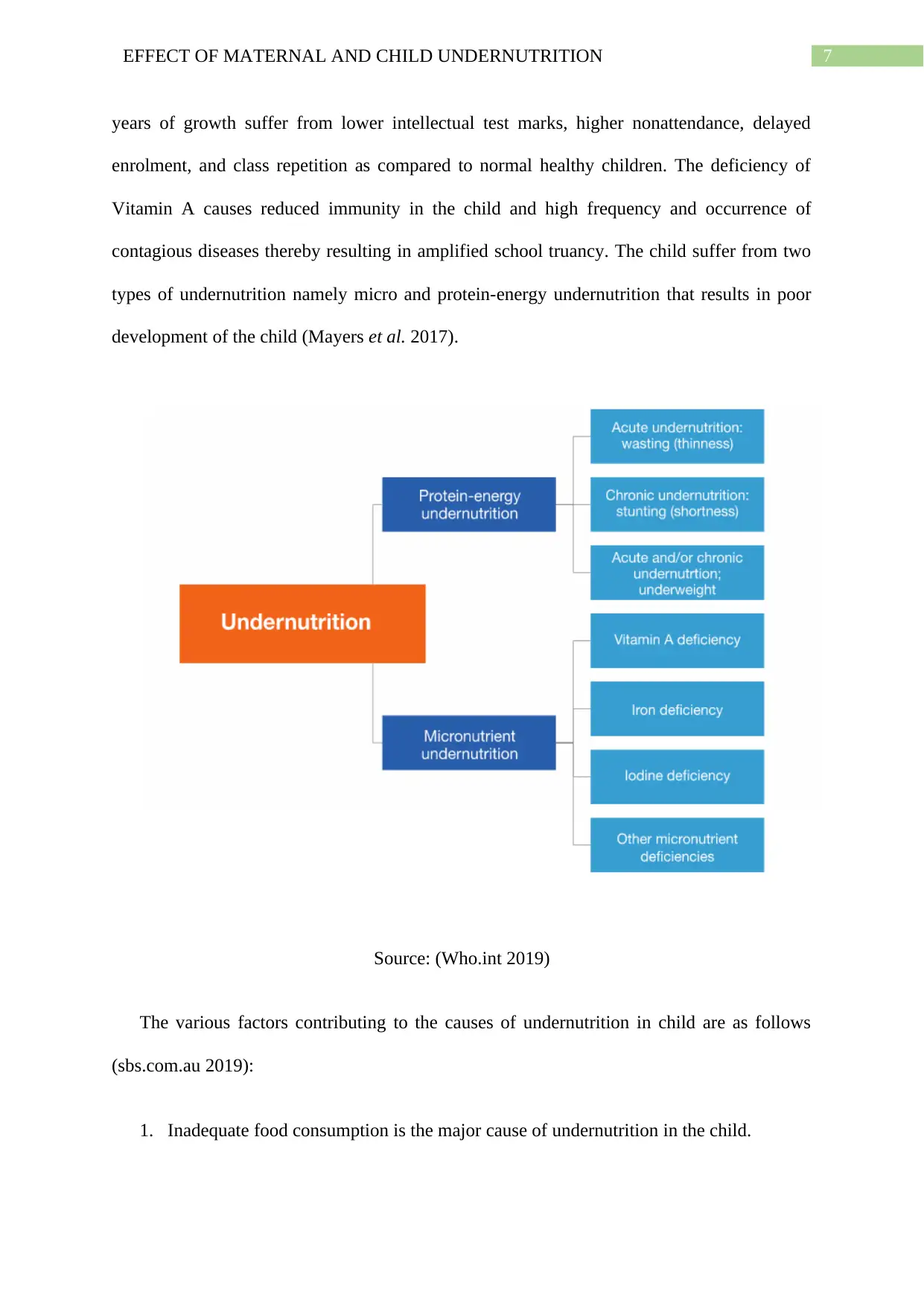
7EFFECT OF MATERNAL AND CHILD UNDERNUTRITION
years of growth suffer from lower intellectual test marks, higher nonattendance, delayed
enrolment, and class repetition as compared to normal healthy children. The deficiency of
Vitamin A causes reduced immunity in the child and high frequency and occurrence of
contagious diseases thereby resulting in amplified school truancy. The child suffer from two
types of undernutrition namely micro and protein-energy undernutrition that results in poor
development of the child (Mayers et al. 2017).
Source: (Who.int 2019)
The various factors contributing to the causes of undernutrition in child are as follows
(sbs.com.au 2019):
1. Inadequate food consumption is the major cause of undernutrition in the child.
years of growth suffer from lower intellectual test marks, higher nonattendance, delayed
enrolment, and class repetition as compared to normal healthy children. The deficiency of
Vitamin A causes reduced immunity in the child and high frequency and occurrence of
contagious diseases thereby resulting in amplified school truancy. The child suffer from two
types of undernutrition namely micro and protein-energy undernutrition that results in poor
development of the child (Mayers et al. 2017).
Source: (Who.int 2019)
The various factors contributing to the causes of undernutrition in child are as follows
(sbs.com.au 2019):
1. Inadequate food consumption is the major cause of undernutrition in the child.
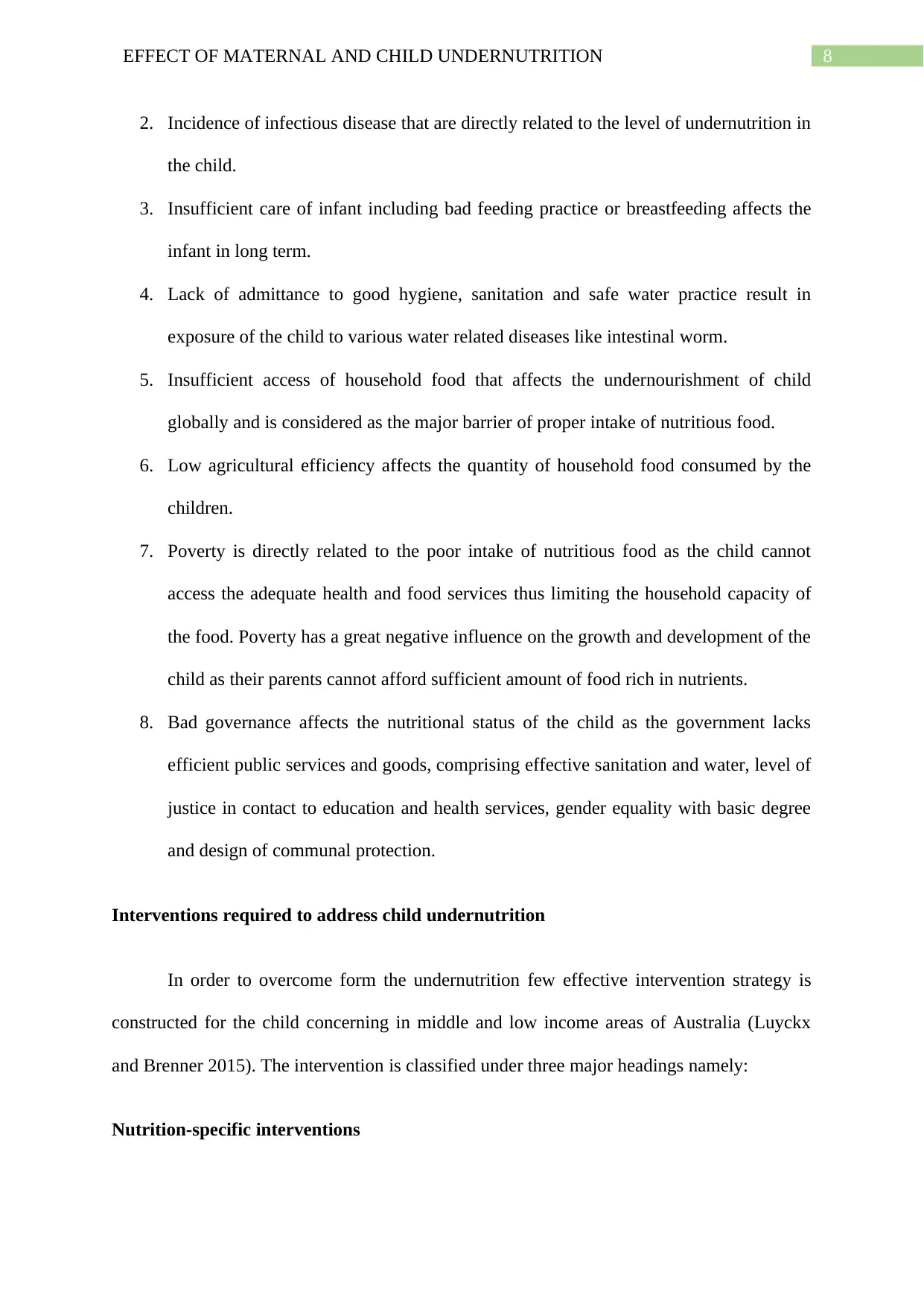
8EFFECT OF MATERNAL AND CHILD UNDERNUTRITION
2. Incidence of infectious disease that are directly related to the level of undernutrition in
the child.
3. Insufficient care of infant including bad feeding practice or breastfeeding affects the
infant in long term.
4. Lack of admittance to good hygiene, sanitation and safe water practice result in
exposure of the child to various water related diseases like intestinal worm.
5. Insufficient access of household food that affects the undernourishment of child
globally and is considered as the major barrier of proper intake of nutritious food.
6. Low agricultural efficiency affects the quantity of household food consumed by the
children.
7. Poverty is directly related to the poor intake of nutritious food as the child cannot
access the adequate health and food services thus limiting the household capacity of
the food. Poverty has a great negative influence on the growth and development of the
child as their parents cannot afford sufficient amount of food rich in nutrients.
8. Bad governance affects the nutritional status of the child as the government lacks
efficient public services and goods, comprising effective sanitation and water, level of
justice in contact to education and health services, gender equality with basic degree
and design of communal protection.
Interventions required to address child undernutrition
In order to overcome form the undernutrition few effective intervention strategy is
constructed for the child concerning in middle and low income areas of Australia (Luyckx
and Brenner 2015). The intervention is classified under three major headings namely:
Nutrition-specific interventions
2. Incidence of infectious disease that are directly related to the level of undernutrition in
the child.
3. Insufficient care of infant including bad feeding practice or breastfeeding affects the
infant in long term.
4. Lack of admittance to good hygiene, sanitation and safe water practice result in
exposure of the child to various water related diseases like intestinal worm.
5. Insufficient access of household food that affects the undernourishment of child
globally and is considered as the major barrier of proper intake of nutritious food.
6. Low agricultural efficiency affects the quantity of household food consumed by the
children.
7. Poverty is directly related to the poor intake of nutritious food as the child cannot
access the adequate health and food services thus limiting the household capacity of
the food. Poverty has a great negative influence on the growth and development of the
child as their parents cannot afford sufficient amount of food rich in nutrients.
8. Bad governance affects the nutritional status of the child as the government lacks
efficient public services and goods, comprising effective sanitation and water, level of
justice in contact to education and health services, gender equality with basic degree
and design of communal protection.
Interventions required to address child undernutrition
In order to overcome form the undernutrition few effective intervention strategy is
constructed for the child concerning in middle and low income areas of Australia (Luyckx
and Brenner 2015). The intervention is classified under three major headings namely:
Nutrition-specific interventions
⊘ This is a preview!⊘
Do you want full access?
Subscribe today to unlock all pages.

Trusted by 1+ million students worldwide

9EFFECT OF MATERNAL AND CHILD UNDERNUTRITION
Nutrition-specific interventions is used to report the instant reasons of undernutrition
in child. In this intervention a target of 1000-day is considered that covers from the gestation
period of pregnancy till initial two years of child age as it is considered as the crucial time to
prevent any intellectual damage (Ross et al.2015). The pregnant mothers are also included in
nutrition-specific interventions comprising adolescent girls before or after their pregnancy, as
the health of pregnant mother directly disturbs the nutritional content of the children. Few
examples included in nutrition-specific interventions are micronutrient supplementation,
advancement of breastfeeding, suitable balancing feeding and nutritional supplementation,
management of severe undernutrition, management and prevention of reasonable severe
undernutrition with adequate source of nutrition during crises.
Nutrition-sensitive interventions
Nutrition-sensitive interventions is used to address the fundamental reasons of child
malnutrition that might be combined in an assortment of different sector programs. Nutrition-
sensitive interventions comprises of plant breeding (agriculture), safe faeces disposal
(hygiene, water and sanitation), social protection, well-being specialized training and exercise
on nutrition concerning health systems, and education primarily enrolment of girls in school.
Nutrition-sensitive interventions might aid as conveyance platforms for various nutrition-
specific interventions thus increasing overall effectiveness, scale and coverage (Hakim 2016).
Interventions comprising the basic reasons of undernutrition
Interventions are required to generate an empowering atmosphere for effective
investments concerning nutrition, which address the simple reason and underlying causes of
undernutrition in children (Victora et al. 2016). The effective investments includes
Nutrition-specific interventions is used to report the instant reasons of undernutrition
in child. In this intervention a target of 1000-day is considered that covers from the gestation
period of pregnancy till initial two years of child age as it is considered as the crucial time to
prevent any intellectual damage (Ross et al.2015). The pregnant mothers are also included in
nutrition-specific interventions comprising adolescent girls before or after their pregnancy, as
the health of pregnant mother directly disturbs the nutritional content of the children. Few
examples included in nutrition-specific interventions are micronutrient supplementation,
advancement of breastfeeding, suitable balancing feeding and nutritional supplementation,
management of severe undernutrition, management and prevention of reasonable severe
undernutrition with adequate source of nutrition during crises.
Nutrition-sensitive interventions
Nutrition-sensitive interventions is used to address the fundamental reasons of child
malnutrition that might be combined in an assortment of different sector programs. Nutrition-
sensitive interventions comprises of plant breeding (agriculture), safe faeces disposal
(hygiene, water and sanitation), social protection, well-being specialized training and exercise
on nutrition concerning health systems, and education primarily enrolment of girls in school.
Nutrition-sensitive interventions might aid as conveyance platforms for various nutrition-
specific interventions thus increasing overall effectiveness, scale and coverage (Hakim 2016).
Interventions comprising the basic reasons of undernutrition
Interventions are required to generate an empowering atmosphere for effective
investments concerning nutrition, which address the simple reason and underlying causes of
undernutrition in children (Victora et al. 2016). The effective investments includes
Paraphrase This Document
Need a fresh take? Get an instant paraphrase of this document with our AI Paraphraser
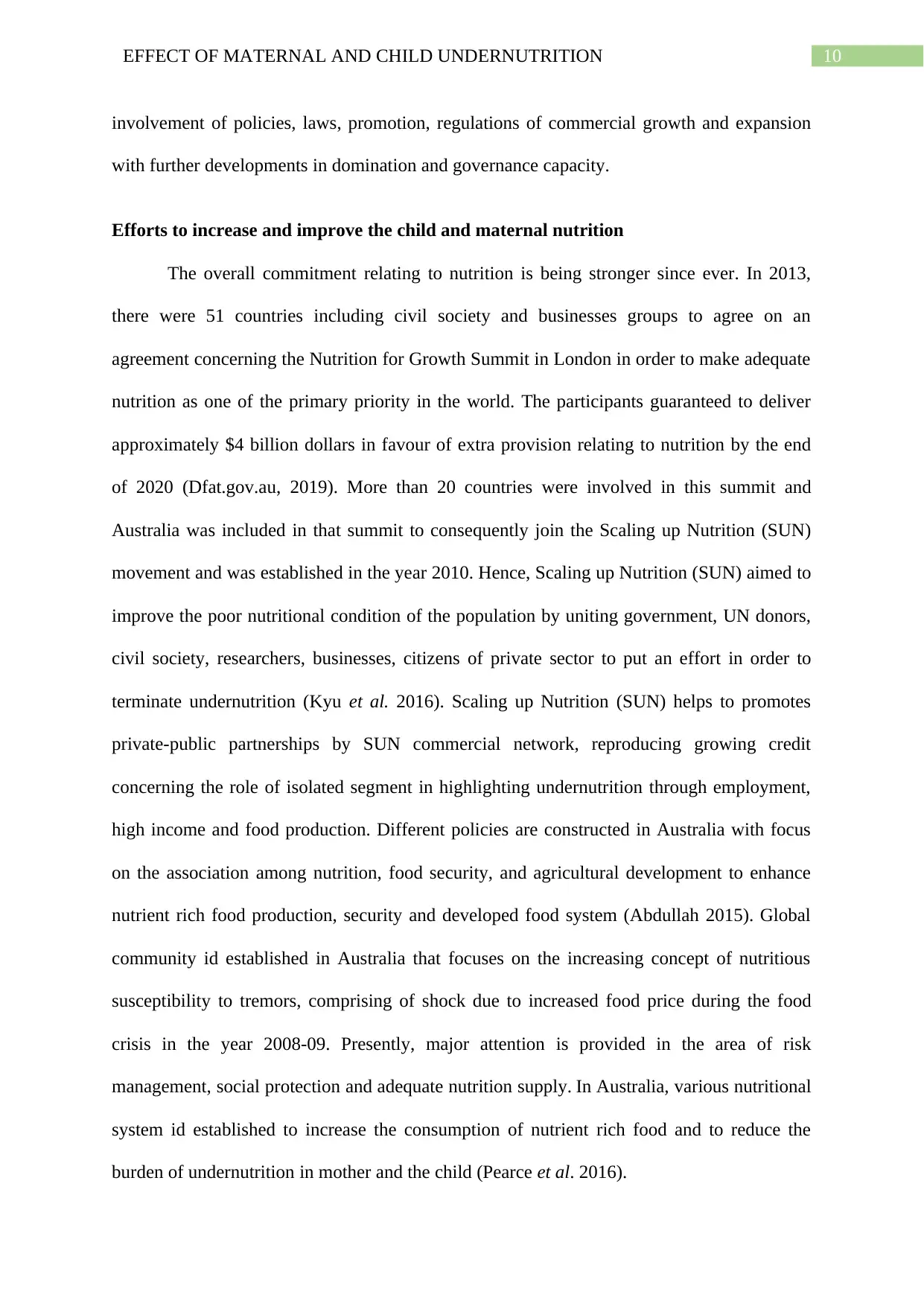
10EFFECT OF MATERNAL AND CHILD UNDERNUTRITION
involvement of policies, laws, promotion, regulations of commercial growth and expansion
with further developments in domination and governance capacity.
Efforts to increase and improve the child and maternal nutrition
The overall commitment relating to nutrition is being stronger since ever. In 2013,
there were 51 countries including civil society and businesses groups to agree on an
agreement concerning the Nutrition for Growth Summit in London in order to make adequate
nutrition as one of the primary priority in the world. The participants guaranteed to deliver
approximately $4 billion dollars in favour of extra provision relating to nutrition by the end
of 2020 (Dfat.gov.au, 2019). More than 20 countries were involved in this summit and
Australia was included in that summit to consequently join the Scaling up Nutrition (SUN)
movement and was established in the year 2010. Hence, Scaling up Nutrition (SUN) aimed to
improve the poor nutritional condition of the population by uniting government, UN donors,
civil society, researchers, businesses, citizens of private sector to put an effort in order to
terminate undernutrition (Kyu et al. 2016). Scaling up Nutrition (SUN) helps to promotes
private-public partnerships by SUN commercial network, reproducing growing credit
concerning the role of isolated segment in highlighting undernutrition through employment,
high income and food production. Different policies are constructed in Australia with focus
on the association among nutrition, food security, and agricultural development to enhance
nutrient rich food production, security and developed food system (Abdullah 2015). Global
community id established in Australia that focuses on the increasing concept of nutritious
susceptibility to tremors, comprising of shock due to increased food price during the food
crisis in the year 2008-09. Presently, major attention is provided in the area of risk
management, social protection and adequate nutrition supply. In Australia, various nutritional
system id established to increase the consumption of nutrient rich food and to reduce the
burden of undernutrition in mother and the child (Pearce et al. 2016).
involvement of policies, laws, promotion, regulations of commercial growth and expansion
with further developments in domination and governance capacity.
Efforts to increase and improve the child and maternal nutrition
The overall commitment relating to nutrition is being stronger since ever. In 2013,
there were 51 countries including civil society and businesses groups to agree on an
agreement concerning the Nutrition for Growth Summit in London in order to make adequate
nutrition as one of the primary priority in the world. The participants guaranteed to deliver
approximately $4 billion dollars in favour of extra provision relating to nutrition by the end
of 2020 (Dfat.gov.au, 2019). More than 20 countries were involved in this summit and
Australia was included in that summit to consequently join the Scaling up Nutrition (SUN)
movement and was established in the year 2010. Hence, Scaling up Nutrition (SUN) aimed to
improve the poor nutritional condition of the population by uniting government, UN donors,
civil society, researchers, businesses, citizens of private sector to put an effort in order to
terminate undernutrition (Kyu et al. 2016). Scaling up Nutrition (SUN) helps to promotes
private-public partnerships by SUN commercial network, reproducing growing credit
concerning the role of isolated segment in highlighting undernutrition through employment,
high income and food production. Different policies are constructed in Australia with focus
on the association among nutrition, food security, and agricultural development to enhance
nutrient rich food production, security and developed food system (Abdullah 2015). Global
community id established in Australia that focuses on the increasing concept of nutritious
susceptibility to tremors, comprising of shock due to increased food price during the food
crisis in the year 2008-09. Presently, major attention is provided in the area of risk
management, social protection and adequate nutrition supply. In Australia, various nutritional
system id established to increase the consumption of nutrient rich food and to reduce the
burden of undernutrition in mother and the child (Pearce et al. 2016).

11EFFECT OF MATERNAL AND CHILD UNDERNUTRITION
⊘ This is a preview!⊘
Do you want full access?
Subscribe today to unlock all pages.

Trusted by 1+ million students worldwide
1 out of 17
Related Documents
Your All-in-One AI-Powered Toolkit for Academic Success.
+13062052269
info@desklib.com
Available 24*7 on WhatsApp / Email
![[object Object]](/_next/static/media/star-bottom.7253800d.svg)
Unlock your academic potential
Copyright © 2020–2025 A2Z Services. All Rights Reserved. Developed and managed by ZUCOL.




